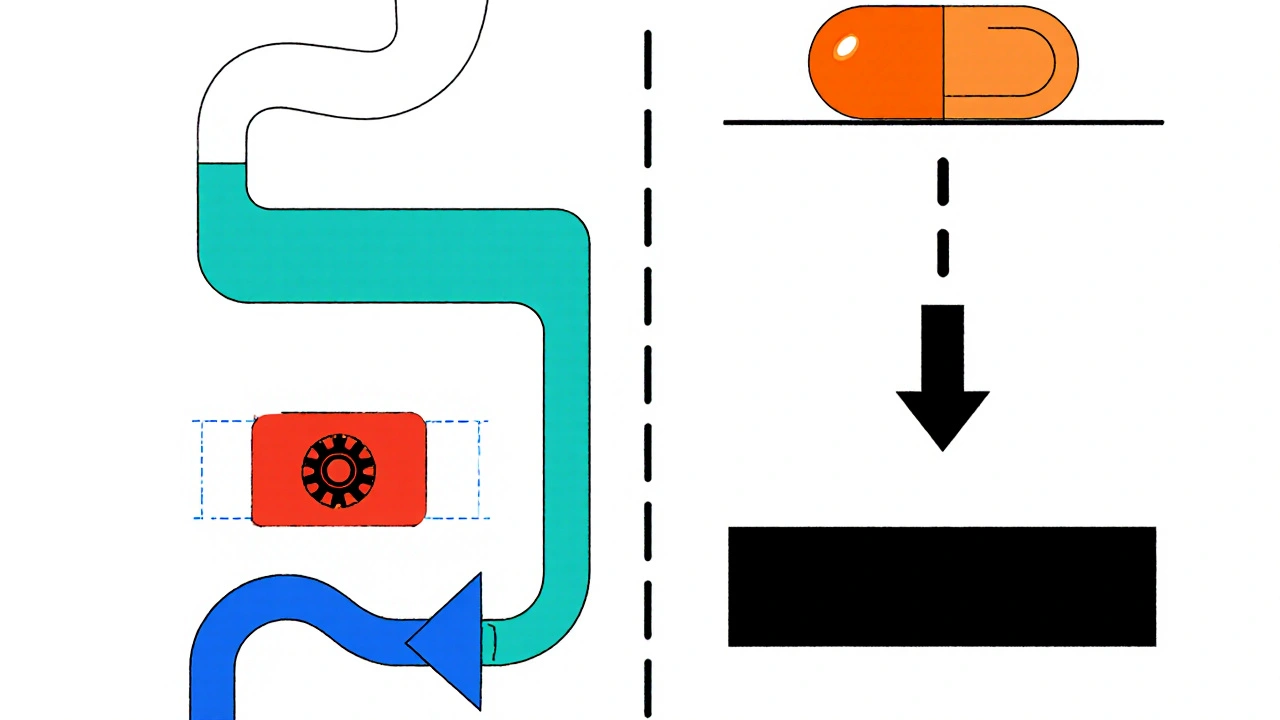How Paroxetine Works - Mechanism, Uses, and Side Effects

Paroxetine Tapering Calculator
This calculator helps you determine a safe tapering schedule to discontinue Paroxetine. Always consult with your healthcare provider before making any changes to your medication regimen.
Current Dose Information
Tapering Schedule
Total taper time:
The antidepressant Paroxetine works by tweaking the chemistry of your brain, easing mood swings and anxiety without a steep learning curve. If you’ve ever wondered what actually happens after you swallow a pill, this guide breaks down the science, the dosing details, and the practical things you need to know before starting treatment.
What Is Paroxetine?
Paroxetine is a selective serotonin reuptake inhibitor (SSRI) that increases the level of serotonin in the synaptic cleft. It was first approved by the FDA in 1992 and is sold under brand names such as Paxil and Seroxat. The drug is mainly prescribed for major depressive disorder, generalized anxiety disorder, social anxiety, panic disorder, and obsessive‑compulsive disorder.
Selective Serotonin Reuptake Inhibitor (SSRI) - The Drug Class
Selective serotonin reuptake inhibitor is a class of drugs that block the serotonin transporter (SERT), preventing the re‑absorption of serotonin into presynaptic neurons. By keeping serotonin available longer, SSRI medications help normalize mood pathways that are often under‑active in depression and anxiety.
Serotonin - The Neurotransmitter at Work
Serotonin is a neurotransmitter that regulates mood, sleep, appetite, and pain perception. In a typical brain, after a nerve impulse releases serotonin into the synapse, about 95% of that serotonin is pulled back into the presynaptic neuron by the serotonin transporter. Paroxetine’s inhibition of this transporter leaves more serotonin hanging around, which boosts signaling to downstream receptors.
Mechanism of Action - How Paroxetine Inhibits Reuptake
The drug binds tightly to SERT, acting as a competitive antagonist. Unlike older tricyclic antidepressants, it does not affect norepinephrine or dopamine reuptake, which is why its side‑effect profile is generally milder. The binding affinity of Paroxetine for SERT is among the highest in the SSRI family, giving it a potent effect even at low doses.

Pharmacokinetics - What Happens After the Pill Is Swallowed
Pharmacokinetics refers to the absorption, distribution, metabolism, and excretion of a drug. After oral administration, Paroxetine reaches peak plasma concentrations in 5-8hours. Food can delay absorption slightly but does not affect overall bioavailability.
- Absorption: About 50% of the dose is absorbed from the gastrointestinal tract.
- Distribution: The drug is highly protein‑bound (≈95%), allowing it to cross the blood‑brain barrier, which is essential for reaching central nervous system targets.
- Metabolism: Liver enzymes, especially CYP2D6, convert Paroxetine into inactive metabolites. Individuals who are poor CYP2D6 metabolizers may experience higher plasma levels and need dose adjustments.
- Elimination: The drug’s half‑life is roughly 21hours, meaning steady‑state concentrations are typically reached after 5‑6 days of daily dosing.
Therapeutic Uses - When Doctors Choose Paroxetine
Depression is a mood disorder characterized by persistent sadness, loss of interest, and impaired daily functioning. Paroxetine has demonstrated efficacy in alleviating these symptoms, particularly when patients also experience anxiety. Other approved indications include:
- Generalized anxiety disorder
- Social anxiety disorder (social phobia)
- Panic disorder
- Obsessive‑compulsive disorder
- Post‑traumatic stress disorder (off‑label in some regions)
Clinicians often start with a low dose (10-20mg daily) and titrate upward based on response and tolerability.
Common Side Effects - What to Expect
Because Paroxetine alters serotonin levels, it can produce a range of predictable side effects:
| System | Side Effect | Frequency |
|---|---|---|
| Gastrointestinal | Nausea, dry mouth | Common |
| Central nervous system | Insomnia, dizziness, headache | Common |
| Sexual | Decreased libido, ejaculation delay | Common |
| Cardiovascular | Increased heart rate, mild hypertension | Less common |
| Other | Weight change, sweating | Occasional |
Most side effects lessen after the first two weeks as the body adapts. If severe nausea or suicidal thoughts appear, contact a healthcare professional immediately.
Drug Interactions - Substances to Watch
Paroxetine’s metabolism through CYP2D6 makes it a frequent culprit in drug‑drug interactions.
- Other serotonergic agents (e.g., tramadol, triptans) can raise the risk of serotonin syndrome - a potentially life‑threatening condition marked by agitation, hyperthermia, and muscle rigidity.
- Monoamine oxidase inhibitors (MAOIs) must be stopped at least 14days before starting Paroxetine to avoid hypertensive crises.
- Warfarin levels can increase, necessitating more frequent INR monitoring.
- Alcohol may intensify drowsiness and impair coordination.
Always provide a full medication list to your prescriber, including over‑the‑counter supplements like St.John’s wort, which also modulates CYP enzymes.
Special Populations - Who Needs a Different Approach?
Pregnancy is a state that requires careful drug selection. Paroxetine is classified as FDA Pregnancy Category D due to a possible association with congenital heart defects. In most cases, clinicians will switch to a safer SSRI, such as sertraline, during pregnancy.
Older adults may experience heightened anticholinergic effects (dry mouth, constipation) because of age‑related changes in liver metabolism. Starting at a lower dose (5mg) is often prudent.
How to Discontinue - Tapering to Avoid Withdrawal
Stopping Paroxetine abruptly can lead to discontinuation syndrome: electric‑shock sensations, irritability, and flu‑like symptoms. A typical taper schedule reduces the dose by 10mg every 1-2weeks, but the exact plan should be individualized.
FAQs
What conditions does Paroxetine treat?
Paroxetine is approved for major depressive disorder, generalized anxiety disorder, social anxiety disorder, panic disorder, and obsessive‑compulsive disorder. Doctors also use it off‑label for post‑traumatic stress disorder and certain chronic pain syndromes.
How long does it take to feel better?
Most patients notice a mild improvement within 1-2 weeks, but the full antidepressant effect often requires 4-6 weeks of consistent dosing.
Can I drink alcohol while taking Paroxetine?
Alcohol can increase drowsiness and worsen side effects, so it’s best to limit intake. If you choose to drink, do so sparingly and monitor how you feel.
Is Paroxetine safe for older adults?
Older adults can take Paroxetine, but they often need lower starting doses because of slower liver metabolism and a higher risk of anticholinergic side effects.
What is serotonin syndrome and how can I avoid it?
Serotonin syndrome occurs when too much serotonin stimulates the nervous system, leading to agitation, rapid heart rate, high fever, and muscle rigidity. Avoid it by not combining Paroxetine with other serotonergic drugs (like triptans or certain pain meds) and by telling your doctor about every medication you use.
How should I taper off Paroxetine?
A typical taper reduces the daily dose by about 10mg every one to two weeks. Your doctor may adjust the schedule based on how you feel, especially if you experience withdrawal symptoms.
Understanding how Paroxetine works helps you make informed decisions with your doctor, set realistic expectations, and manage any side effects efficiently. Armed with this knowledge, you can take control of your mental‑health journey.
Richard O'Callaghan
October 17, 2025 AT 17:02Just a heads up, if you’re thinking about starting Paroxetine, make sure you start low, like 10mg, and watch the GI upset – it’s common and can be pretty nasty. The drug hits the brain in 5‑8 hours, so don’t expect instant relief. Also, if you’re a poor CYP2D6 metabolizer, you might feel the lo effect a lot stronger, so tell your doc. And yeah, the half‑life is about 21 horas, so it builds up if you miss a dose. Lastly, tapering is key, otherwise you’ll get the electric‑shock feeling.
Alexis Howard
October 23, 2025 AT 06:22actually side effects are overrated
Darryl Gates
October 28, 2025 AT 19:42When you begin a course of Paroxetine, the most important step is to establish a clear communication line with your prescriber.
Tell them about any other medications, including over‑the‑counter supplements, because of the drug’s strong CYP2D6 interactions.
A low starting dose, typically 10 mg per day, helps the body adjust to the increased serotonin levels.
Most patients notice a mild reduction in anxiety within the first two weeks, but full therapeutic effect may take four to six weeks.
If nausea occurs, taking the pill with food can lessen the discomfort without affecting overall absorption.
Watch for signs of serotonin syndrome, especially if you are using other serotonergic agents such as triptans or certain pain medications.
Regular monitoring of blood pressure and heart rate is advisable, as Paroxetine can cause mild hypertension in some individuals.
Older adults often benefit from starting at 5 mg because liver metabolism can be slower, reducing the risk of anticholinergic side effects.
Women who are pregnant should discuss alternative SSRIs, since Paroxetine falls into FDA Category D for potential fetal heart defects.
If you experience insomnia, consider taking the medication in the morning rather than at night.
Weight changes are possible, so maintain a balanced diet and stay active throughout treatment.
Should you need to discontinue, a gradual taper-reducing the dose by about 10 mg every one to two weeks-helps avoid withdrawal symptoms.
In case of severe nausea or emergent suicidal thoughts, seek medical attention immediately.
Overall, adherence to the prescribed regimen and open dialogue with your healthcare team are the foundations of a successful outcome.
Remember that each person’s response is unique, so be patient and give the medication time to work.
Kevin Adams
November 3, 2025 AT 09:02Ah, the mind’s tides are relentless, and Paroxetine merely offers a fragile raft against the storm. Yet, even the most steadfast raft can crack if the waters of serotonin become too turbulent. One must wield this potion with reverence, lest the very currents that calm also consume.
Katie Henry
November 8, 2025 AT 22:22Esteemed readers, it is paramount to approach Paroxetine therapy with both diligence and optimism. By adhering to the prescribed titration schedule, you empower your neurochemistry toward equilibrium. Should challenges arise, remember that your healthcare team stands ready to adjust and support your journey. Let us stride forward with confidence and informed resolve.
Joanna Mensch
November 14, 2025 AT 11:42Behind the glossy brochures lies a network of undisclosed trials, where data may be curated to conceal latent risks. The pharmaceutical giants profit from silence, and the subtle manipulations of serotonin could mask deeper agendas. Keep your own records, question the sources, and never surrender your autonomy without scrutiny.
RJ Samuel
November 20, 2025 AT 01:02Yo, I hear the hype about Paroxetine but honestly it’s just a fancy mood‑mask; you could get the same chill from a solid jog or a good night’s sleep. Don’t let the docs sell you a pill when the real fix is kicking ass in the gym.
Nickolas Mark Ewald
November 25, 2025 AT 14:22While exercise certainly boosts serotonin naturally, medication like Paroxetine can be a valuable tool for those who need additional support, especially when lifestyle changes alone aren’t enough.